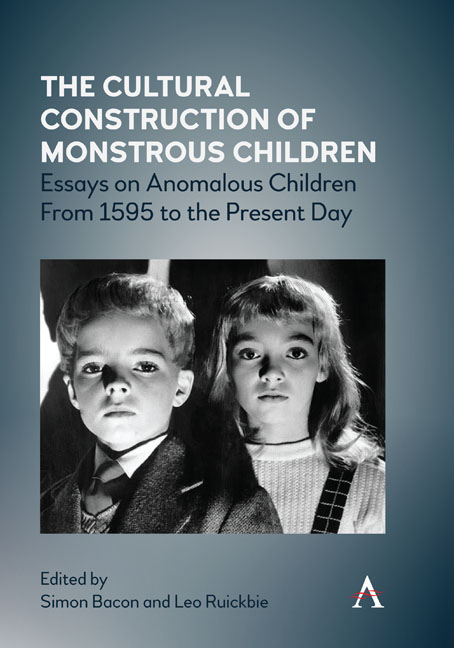 The Cultural Construction of Monstrous Children
The Cultural Construction of Monstrous Children Book contents
- Frontmatter
- Contents
- List of Illustrations
- Acknowledgements
- Introduction
- Part I Historical Case Studies
- Part II Factual Anxiety in Fictional Representations: The Undead Child
- Part III Factual Anxiety in Fictional Representations: The Monstrous Child
- Part IV Cultural Categorization in the Past, Present and Possible Future
- Notes on Contributors
- Index
Chapter Three - Was a Real Teenage Werewolf: The Seventeenth-Century Witchcraft Trial of Jean Grenier
Published online by Cambridge University Press: 20 January 2022
- Frontmatter
- Contents
- List of Illustrations
- Acknowledgements
- Introduction
- Part I Historical Case Studies
- Part II Factual Anxiety in Fictional Representations: The Undead Child
- Part III Factual Anxiety in Fictional Representations: The Monstrous Child
- Part IV Cultural Categorization in the Past, Present and Possible Future
- Notes on Contributors
- Index
Summary
‘He Had Very Long and Bright Teeth’: Meeting the Werewolf
France, a little more than four hundred years ago: the witch-hunter Pierre de Lancre, recently returned from mass persecutions in the Basque country, paid a visit to a monastery in Bordeaux. Forget Michael J. Fox as the howl-at-the-moon teenager in Teen Wolf, playing lycanthropy as a metaphor for puberty, or Seth Green's character in Buffy the Vampire Slayer, or any of the others since – de Lancre was about to meet the real thing. The ‘real thing’ was Jean Grenier, then aged about 20, sentenced to perpetual confinement in a monastery for his terrible crimes: witchcraft, murder and cannibalism. The original trial records have been lost, and it is only from the published account of de Lancre that we learn the gruesome details of the case. While a partially fictionalized version written by the Rev. Sabine Baring-Gould has been available in English since 1865, de Lancre's own work was not translated until 2006. Until now, no serious attempt has been made to try and reconstruct events or contextualize the case.
For some time, no one even seemed to know where any of this had taken place. Baring-Gould described some of the action taking place on a sandy beach by the Bay of Biscay. The colourful witch-monger Montague Summers thought events had unfolded in the Landes – the flat marshy area to the south of Bordeaux. With the help of maps produced by the Institut Geographique National – the French equivalent of Ordnance Survey – I could identify most of the places de Lancre mentioned. All of them were located in a region called La Double to the north-east of Bordeaux. It is five hundred square kilometres of forested hill-country that was only marginally tamed in the nineteenth century with a programme of road building, marsh draining and soil improvement. Even then it was still an inaccessible, isolated region of poverty and desolation whose history was one of fever, robbery and wolves. And, of course, werewolves.
It is an unusual case because the accused voluntarily confessed to all of the crimes put before him without the apparent use or threat of torture.
- Type
- Chapter
- Information
- The Cultural Construction of Monstrous ChildrenEssays on Anomalous Children from 1595 to the Present Day, pp. 53 - 70Publisher: Anthem PressPrint publication year: 2020


